The Corsair SP (Static Pressure), AF (High Airflow) 120/140mm Fan Review
by E. Fylladitakis on November 25, 2015 8:00 AM EST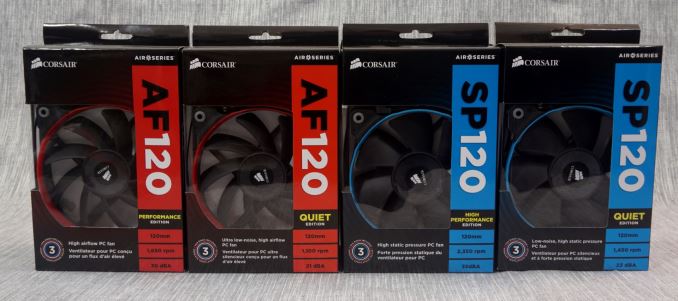
Both the selection and the testing of a fan can be a rather complicated matter. Even if someone knows the exact performance curve of a fan and can make an educated assessment regarding the airflow impedance, parameters such as the quality and noise come into play as well. Through our fan reviews, we will attempt to simplify some of these parameters and assist you with making a proper selection. Today we are looking at several of Corsair's high-end fan offerings in the 120mm and 140mm size from their SP (Static Pressure), AF (High Airflow) and LED ranges.
Introduction
As this is our first proper fan review, our primary focus is to showcase and explain the differences between different kinds of fans, as well as to begin the composing of a performance database. Corsair is our company of choice for our first review, as they offer a variety of cooling fans wide enough and designed for different applications, permitting us to easily showcase the difference between fan designs. Corsair supplied us with six different fan products, which are:
- The AF140 LED White Quiet Edition 140mm fan (High Airflow)
- The SP140 LED White 140mm fan (High Static Pressure)
- The AF120 Performance Edition 120mm fan (High Airflow)
- The SP120 Performance Edition 120mm fan (High Static Pressure)
- The AF120 Quiet Edition 120mm fan (High Airflow)
- The SP120 Quiet Edition 120mm fan (High Static Pressure)
Theoretically Corsair's offerings end up with many degrees of freedom - select AF or SP, select 120mm or 140mm, then select Performance or Quiet, the LED or no LED. This could lead up to 16 different combinations (colors of LED not withstanding), although Corsair picks and chooses so only a few of these to produce.
The Fans
We should start by immediately mentioning that the LED fan versions are not of equal design and performance as the standard versions. We will examine these differences thoroughly, but take care not to confuse the standard with the LED versions of each fan. For example, the AF140 Quiet Edition and the LED version (the AF140 LED White Quiet Edition) do share a similar product number but the non-LED version ends up having significantly better performance specifications.
The LED versions of the AF140 and the SP140 both have black plastic frames with narrowed bezels and semi-transparent blades with a "frost" texture. The wiring and the connector, as well as the provided screws, are all black.
There are four LED lights installed on the frame, in parallel with the plastic engine support bars. We received the white version of the fans but they are also available in blue, red, green and purple.
The AF140 and the SP140 side-by-side look almost identical, with the exception of the fan's blades. The high airflow AF140 has more (11) and narrow blades, capable of creating higher airflow when there is no restriction, while the SP140 has fewer (7) and wider blades, allowing it to create higher pressure and overcome airflow obstacles.
A mere look on the non-LED version of the fans is enough to reveal that they are higher performance designs than the LED versions. The plastic frame is about the same but it is of higher quality and there are hard rubber anti-vibration supports. A colored ring surrounds the intake side of the fan. By default, the SP series fans come with the blue ring and the AF series fans with the red ring installed out of the box, but all three colors (blue, red and white) are included in each package.
The Quiet and Performance versions of both the AF120 and the SP120 120 mm fans are physically identical to each other. Once again, the large differences are between the AF120 and the SP120 version fans, with the former having more and narrow blades and the latter fewer and very wide blades. However, the number, shape and angle of the blades is different than their LED counterparts, which explains their significantly different performance specifications.
Corsair advertises the SP120 and AF120 fans, both the Performance and the Quiet editions, as having a "hydraulic bearing". A hydraulic bearing technically is a sleeve bearing with the bearing and axle immersed and sealed in fluid. Technically, the axle and the sleeving do not come in contact with each other, as the fluid interferes. Unfortunately, we could not capture this in a mere picture, as the destruction of the seal and the removal of the shaft disappeared the fluid within it.
If one looks closely at the specifications of the AF140 LED and the SP140 LED fans, as well as all of the LED versions, they will notice that there is no mention of an "advanced hydraulic bearing". This is because the LED versions of the fans have an entirely different engine. When we broke the seal and removed the impeller, what we found was a self-pumping rifle bearing, which is yet another improvement of the standard sleeve bearing. What the rifle bearing does is that it uses the motion of the fan's axle itself to serve as a pump, constantly moving lubricant around the axle and the bearing. The lubricant is sealed in using a rubber seal at the top of the axle and a permanent seal at the bottom.


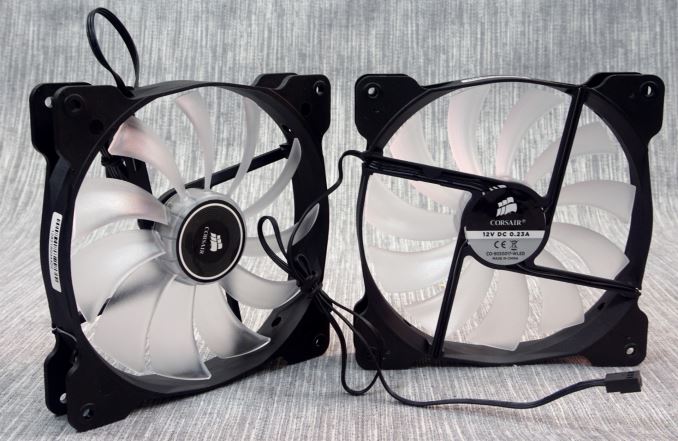

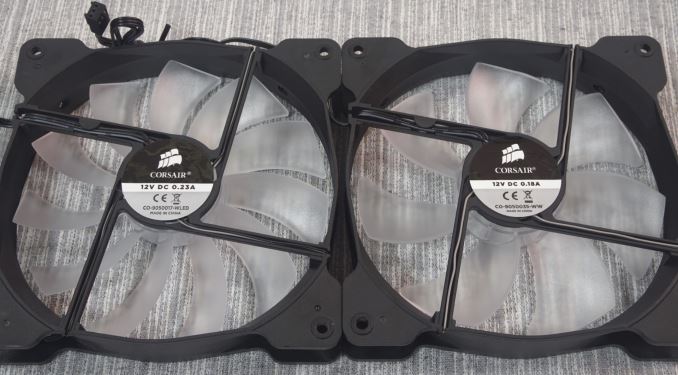
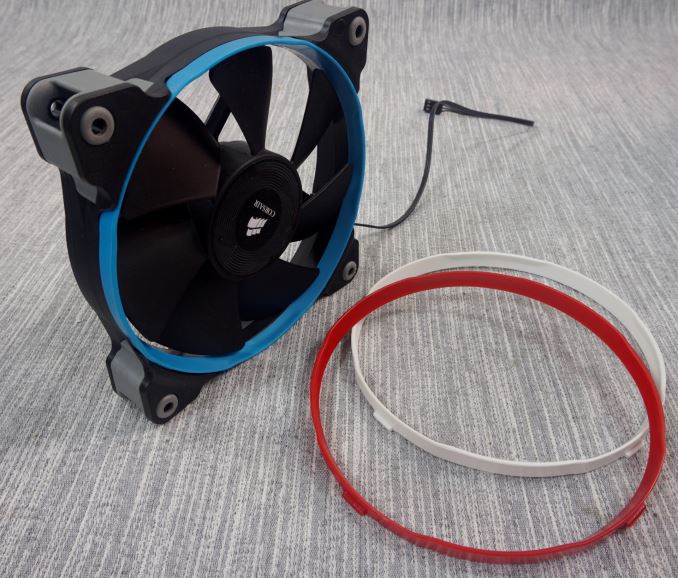
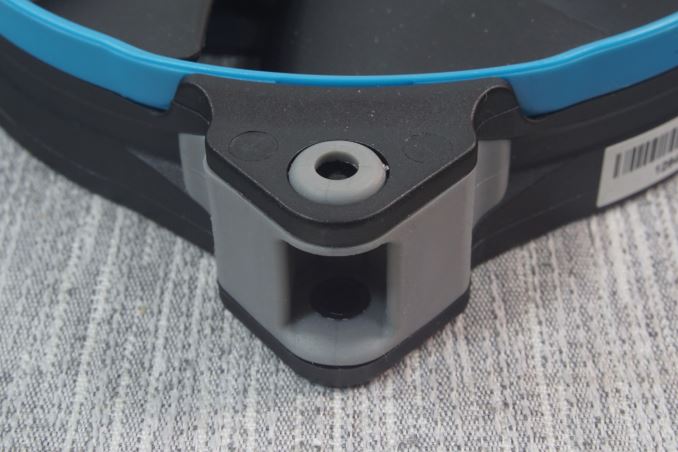
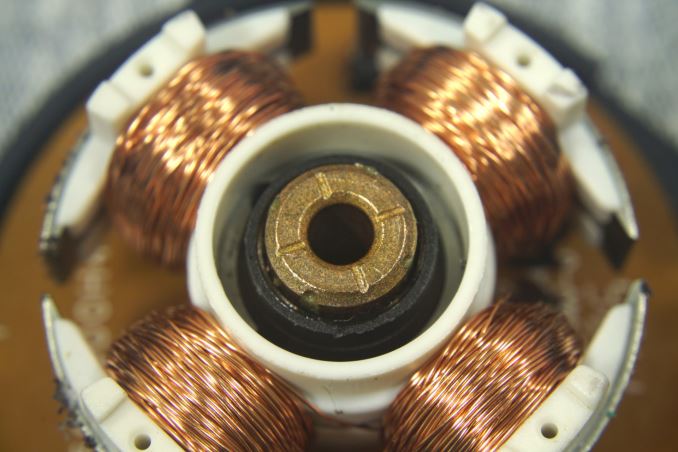
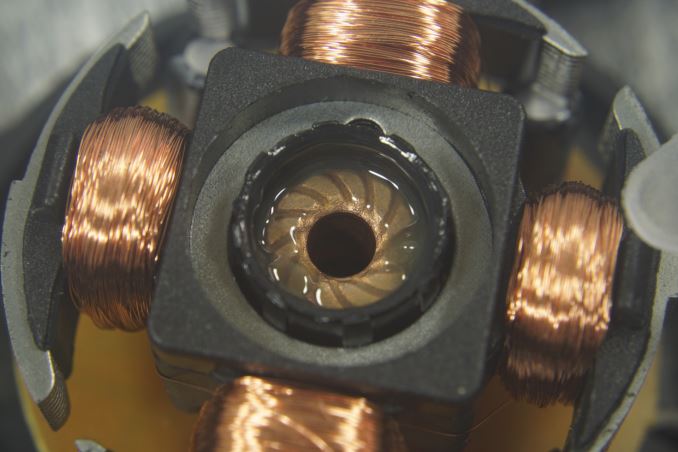
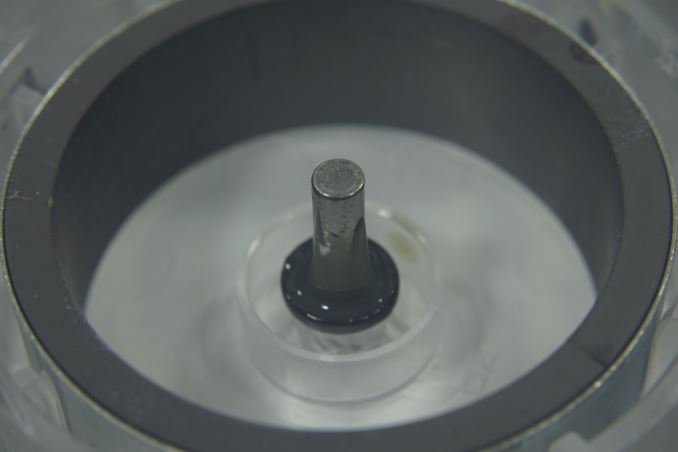








92 Comments
View All Comments
nutral - Thursday, November 26, 2015 - link
He actually did use a anemometer for the airflow test i think. The pitot tube is just used for static pressure readings. I'd say the measuring setup is pretty accurate for what he is doing here. All in all its a great way to measure actual fan performance instead of going after just a flow number and a static pressure number.From my work as an engineer i'm more used to seeing actual graphs of pressure/flow and power to make a good selection. Papst for example does supply them. The only computer fan i've seen else that show these are ek waterblocks
http://img.ebmpapst.com/products/grafik/7438-GRAFI...
https://shop.ekwb.com/media/catalog/product/cache/...
kalboston - Thursday, November 26, 2015 - link
Thank you, I meant to write vane anemometer instead of a pitot tube. As long a the same equipment is to be used these fan comparisons are effective.Just some points to make about the equipment used. Not to say the article is not accurate, but the equipment used is "inexpensive" by trade standards. Such as some of my equipment that I have for those once in a while measurements. The temp/RH, sound, and vibration equipment I own is "cheap" compared to people who specialize in it the field. I wouldn't expect Anand to be using $2,000+ USD thermal anemometers (TSI 9565P temp and barometric compensation) and $2,000+ USD (Shortridge ADM-880C) digital manometers.
The Extech AN200 description does say a thermal anemometer, but the picture shown is a vane anemometer with a FPM accuracy of 3% reading + 40 FPM.
Assuming a 140mm diameter @ 60 CFM = approximately 600 FPM velocity. The AN200 unit is +/- 10% at this reading.
The HD350 accuracy is +/- 0.3% of full scale @ 510 mm h2o = +/- 1.5 mm h2o. Most the readings taken are within the tolerance of the meters accuracy.
I do enjoy reading the author's articles. I have never posted before to Anand, I just hope a few people will hopefully understand before attacking/leaving harsh criticism of the article.
jann5s - Thursday, November 26, 2015 - link
Love the quote in the end, and I'm an engineerTunnah - Thursday, November 26, 2015 - link
Great article, super technical as always, and as usual WAY WAY over my head ha.What I think would be useful is a real world scenario that dumdums like me could look at and see the benefits of. Say, an overclocked CPU with a certain cooler, and the temperature taken with the normal fan, then taken with the custom fan, so we can see the benefit we care about - how much cooler it makes something.
If this isn't possible, due to the fans not fitting, maybe another scenario, a system instead of a CPU cooler, with it's standard fans, then these fans.
I know this probably won't be a popular idea as AnandTech is more for the tech savvy crowd, I just feel like some real world results would help
nutral - Friday, November 27, 2015 - link
This article is mostly about how much flow the fans actually create in certain situations.It can be coupled with how much cooling you have at a certain flow, altough that really depends on the cooler/aio
galta - Thursday, November 26, 2015 - link
Noctua fans, always and forever.The best combination of static pressure and airflow for a given noise level. On top of that, they last close to forever.
Of course, one has to say that they are from beautiful, but that's minor.
Oxford Guy - Thursday, November 26, 2015 - link
They make boring black fans, too.galta - Friday, November 27, 2015 - link
Sure they do. Their industrial line is black/dark brown.I have 6 of them on my system, on a push-pull 3x120mm radiator. Nothing short of superb.
They come at price, though, and not because of their color, but because of their extra specs.
Anyway, as I said before, color is minor.
FriendlyUser - Friday, November 27, 2015 - link
Great, rigorous review!! This is exactly the kind of fan review that I want. Please do a roundup of premium fans soon.Omega215D - Friday, November 27, 2015 - link
Time to compare it to the H.E.C Cougar and Noctua fans.